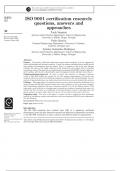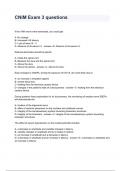The current issue and full text archive of this journal is available at
www.emeraldinsight.com/0265-671X.htm
IJQRM
26,1 ISO 9001 certification research:
questions, answers and
approaches
38
Paulo Sampaio
Systems and Production Department, School of Engineering,
Received April 2008
Revised August 2008 University of Minho, Braga, Portugal
Accepted August 2008 Pedro Saraiva
Chemical Engineering Department, University of Coimbra,
Coimbra, Portugal, and
António Guimarães Rodrigues
Systems and Production Department, School of Engineering,
University of Minho, Braga, Portugal
Abstract
Purpose – The majority of ISO 9001 certification research studies conducted so far are supported by
survey methodologies and descriptive statistics. As such, they express conclusions that are mainly derived
from opinions and perceptions about the subject. Thus, it is common to find in the open literature
references that point out the highly subjective results derived from such studies (often of somewhat
contradictory nature). This paper tries to compile the main conclusions that ISO 9001 research studies have
tried to address, with the aim of describing the quality management systems literature state-of-the-art.
Design/methodology/approach – In order to achieve this objective, an exhaustive literature
review of ISO 9000 studies was carried out. For that purpose approximately 100 articles were
analysed, which were sorted in the following categories, according to the used methodology: surveys;
analysis of financial indicators; case studies; interviews; literature review; and statistical data analysis.
Findings – This paper reflects an exhaustive literature review, which allowed the identification of a
group of issues that ISO 9001 research studies have tried to address, as well as the most commonly
used methodologies employed and main conclusions reached so far by the different authors. Then
using such a state-of-the-art as a starting point, it pointed out a number of questions that seem to be
relevant but have not been so far addressed in the open literature in terms of providing clear and
precise answers, as well as others that are at the core of the authors’ future work in this area.
Originality/value – The value of the paper is to point out and to compile the main conclusions
reached by the different authors and researchers in the most important ISO 9001 issues addressed in
the open literature.
Keywords ISO 9000 series, Assessment, Research
Paper type General review
Introduction
The ISO 9000 standards have resulted since 1987 in a significant worldwide
International Journal of Quality & phenomenon, given the quite impressive growth and diffusion of registrations according
Reliability Management to the ISO 9001 standard in so many countries and different kinds of organisations.
Vol. 26 No. 1, 2009
pp. 38-58
q Emerald Group Publishing Limited
0265-671X
The authors acknowledge financial support provided by Fundação para a Ciência e a Tecnologia
DOI 10.1108/02656710910924161 (FCT) through PhD research grant (BD/16032/2004).
, Therefore, it is not surprising that a reasonable number of researchers have tried to ISO 9001
address topics related with such standards. From an exhaustive search in the open certification
literature, we identified and carefully studied a total of 92 articles related with this
topic, from which we derived a conceptual map (Figure 1) that illustrates the major research
questions addressed.
The most common research methodology adopted by the different authors
corresponds to the use of survey techniques (Figure 2). 39
Only for two, out of the above nine main questions addressed (Q1 and Q8), were we
able to find out that other research techniques tended to be adopted, so that in both
cases hard data evidence is predominantly used to support the authors’ conclusions
(Table I).
Figure 1.
Major ISO 9000 issues that
previously published
studies have tried to
address
Figure 2.
Pareto analysis of research
techniques employed by
researchers
, employed
research techniques
predominant associated
publications and
Major ISO 9000
Table I.
40
26,1
IJQRM
Statistical data
Surveys Analysis of financial indicators Case studies Interviews Literature review analysis
Mann and Kehoe (1994) Wisner and Eakins (1994) Mo and Chan (1997) Mann and Kehoe Stevenson and Saraiva and
(1994) Barnes (2001) Duarte (2003)
Maani et al. (1994) Lima et al. (2000) Staines (2000) Curkovic and Magd and Curry
Pagell (1999) (2003b)
Idris et al. (1996) Heras et al. (2001, 2002a, b) Withers and Ebrahimpour
(2000, 2001)
LRQA (1996) Aarts and Vos (2001) Gustafsson et al. (2001)
Adam et al. (1997) Beirão and Sarsfield Cabral Dwyer (2002)
(2002)
Buttle (1997) Corbett et al. (2002, 2003)
Chapman et al. (1997) Nicolau and Sellers (2002)
Jones et al. (1997) Tsekouras et al. (2002)
Mo and Chan (1997) Wayhan et al. (2002)
Terziovski et al. (1997, 2003)
Brown et al. (1998)
Bryde and Slocock (1998)
Kannan et al. (1999) Chow-Chua et al. (2003)
Lee and Palmer (1999) Martı́nez-Costa and
Martı́nez-Lorente (2003)
Leung et al. (1999) Dimara et al. (2004)
Lipovatz et al. (1999) Naser et al. (2004)
Ragothaman and Korte (1999)
Terziovski and Samson (1999)
Al-khalifa and Aspinwall (2000)
Gupta (2000)
Haversjo (2000)
Romano (2000)
Sun (2000)
Casadesús et al. (2001, 2004)
Escanciano et al. (2001a, b, 2002)
Gotzamani and Tsiotras (2001,
2002)
(continued)





